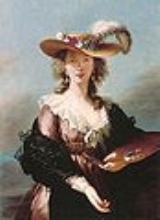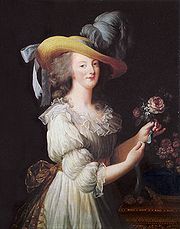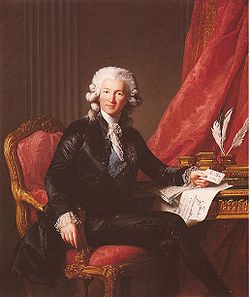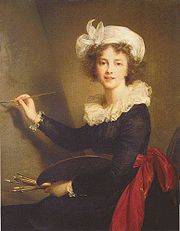
Élisabeth-Louise Vigée Le Brun
Encyclopedia
Louise Élisabeth Vigée Le Brun (Marie Élisabeth Louise; 16 April 1755 – 30 March 1842) was a French painter
, and is recognized as the most famous female painter of the 18th century. Her style is generally considered Rococo
and shows interest in the subject of neoclassical
painting. Vigée Le Brun cannot be considered a pure Neoclassist, however, in that she creates mostly portraits in Neoclassical dress rather than the History painting
. In her choice of color and style while serving as the portrait painter to Marie Antoinette
, Vigée Le Brun is purely Rococo.
 On 7 August 1775 she married Jean-Baptiste-Pierre Le Brun, a painter and art dealer. (Her husband's great uncle was Charles Le Brun
On 7 August 1775 she married Jean-Baptiste-Pierre Le Brun, a painter and art dealer. (Her husband's great uncle was Charles Le Brun
, first Director of the French Academy under Louis XIV.) Vigée Le Brun painted portraits of many of the nobility of the day and as her career blossomed, she was invited to the Palace of Versailles
to paint Marie Antoinette
. So pleased was the queen that during a period of six years, Vigée Le Brun would paint more than thirty portraits of the queen and her family, leading to her being commonly viewed as the official portraitist of Marie Antoinette. Whilst of benefit during the reign of the Bourbon royals, this label was to prove problematic later.
On 12 February 1780, Vigée Le Brun gave birth to a daughter, Jeanne Julie Louise, whom she called "Julie".
 In 1781 she and her husband toured Flanders
In 1781 she and her husband toured Flanders
and the Netherlands
where seeing the works of the Flemish masters inspired her to try new techniques. There, she painted portraits of some of the nobility, including the Prince of Nassau
.
On 31 May 1783, Vigée Le Brun was accepted as a member of France's Académie Royale de Peinture et de Sculpture. She submitted numerous portraits along with an allegorical history painting which she considered her morceau de réception—La Paix qui ramène l'Abondance (Peace Bringing Back Prosperity). The Academy did not place her work within an academic category of type of painting—history or portraiture.
Adélaïde Labille-Guiard
also was admitted on the same day. The admission of Vigée Le Brun was opposed on the grounds that her husband was an art dealer, but eventually they were overruled by an order from Louis XVI
because Marie Antoinette put considerable pressure on her husband on behalf of her painter. The admission of more than one woman on the same day to the Académie encouraged comparisons among the works of the women instead of one woman contrasted with the existing members, who were men.
In 1789, she was succeeded as court painter to Marie Antoinette by Alexander Kucharsky
.
Vigée Le Brun fled France with her young daughter Julie. She lived and worked for some years in Italy
, Austria
, and Russia
, where her experience in dealing with an aristocratic clientele was still useful. In Rome
, her paintings met with great critical acclaim and she was elected to the Roman Accademia di San Luca
.
In Russia, she was received by the nobility and painted numerous aristocrats including the last king of Poland Stanisław August Poniatowski and members of the family of Catherine the Great
. Although the French aesthetic was widely admired in Russia there remained some cultural differences in what was deemed acceptable. Catherine was not initially happy with Vigée Le Brun's portrait of her granddaughters, Elena and Alaxandra Pavlovna, due to the area of bare skin the short sleeved gowns revealed. In order to please the Empress, Vigée Le Brun added sleeves giving the work its characteristic look. This tactic seemed effective in pleasing Catherine as she agreed to sit herself for Vigée Le Brun (although Catherine died of a stroke before this work was due to begin).
 While in Saint Petersburg, Vigée Le Brun was made a member of the Academy of Fine Arts of Saint Petersburg. Much to Vigée Le Brun's dismay, her daughter Julie married a Russian nobleman.
While in Saint Petersburg, Vigée Le Brun was made a member of the Academy of Fine Arts of Saint Petersburg. Much to Vigée Le Brun's dismay, her daughter Julie married a Russian nobleman.
After a sustained campaign by her ex-husband and other family members to have her name removed from the list of counter-revolutionary émigrés, Vigée Le Brun was finally able to return to France during the reign of Emperor Napoleon I
. In spite of being no longer labeled as émigrée, her relationship with the new regime was never totally harmonious, as might be expected given that she was a strong royalist and the former portraitist of Marie Antoinette.
Much in demand by the élite of Europe
, she visited England
at the beginning of the 19th century and painted the portrait of several British notables including Lord Byron
. In 1807 she traveled to Switzerland
and was made an honorary member of the Société pour l'Avancement des Beaux-Arts of Geneva
.
She published her memoirs in 1835 and 1837, which provide an interesting view of the training of artists at the end of the period dominated by royal academies. Her portrait of fellow neoclassical painter, Hubert Robert
, is in Paris at Musée National du Louvre
.
Still very active with her painting in her fifties, she purchased a house in Louveciennes
, Île-de-France
, and lived there until the house was seized by the Prussian
Army during the war in 1814. She stayed in Paris until her death on 30 March 1842 when her body was taken back to Louveciennes and buried in the Cimetière de Louveciennes
near her old home.
Her tombstone epitaph
states "Ici, enfin, je repose…" (Here, at last, I rest…).
Vigée Le Brun left a legacy of 660 portraits and 200 landscapes. In addition to private collections, her works may be found at major museums, such as Hermitage Museum
, London's National Gallery, in Europe and the United States
.
Painting
Painting is the practice of applying paint, pigment, color or other medium to a surface . The application of the medium is commonly applied to the base with a brush but other objects can be used. In art, the term painting describes both the act and the result of the action. However, painting is...
, and is recognized as the most famous female painter of the 18th century. Her style is generally considered Rococo
Rococo
Rococo , also referred to as "Late Baroque", is an 18th-century style which developed as Baroque artists gave up their symmetry and became increasingly ornate, florid, and playful...
and shows interest in the subject of neoclassical
Neoclassicism
Neoclassicism is the name given to Western movements in the decorative and visual arts, literature, theatre, music, and architecture that draw inspiration from the "classical" art and culture of Ancient Greece or Ancient Rome...
painting. Vigée Le Brun cannot be considered a pure Neoclassist, however, in that she creates mostly portraits in Neoclassical dress rather than the History painting
History painting
History painting is a genre in painting defined by subject matter rather than an artistic style, depicting a moment in a narrative story, rather than a static subject such as a portrait...
. In her choice of color and style while serving as the portrait painter to Marie Antoinette
Marie Antoinette
Marie Antoinette ; 2 November 1755 – 16 October 1793) was an Archduchess of Austria and the Queen of France and of Navarre. She was the fifteenth and penultimate child of Holy Roman Empress Maria Theresa and Holy Roman Emperor Francis I....
, Vigée Le Brun is purely Rococo.
Marie Antoinette

Charles Le Brun
Charles Le Brun , a French painter and art theorist, became the all-powerful, peerless master of 17th-century French art.-Biography:-Early life and training:...
, first Director of the French Academy under Louis XIV.) Vigée Le Brun painted portraits of many of the nobility of the day and as her career blossomed, she was invited to the Palace of Versailles
Palace of Versailles
The Palace of Versailles , or simply Versailles, is a royal château in Versailles in the Île-de-France region of France. In French it is the Château de Versailles....
to paint Marie Antoinette
Marie Antoinette
Marie Antoinette ; 2 November 1755 – 16 October 1793) was an Archduchess of Austria and the Queen of France and of Navarre. She was the fifteenth and penultimate child of Holy Roman Empress Maria Theresa and Holy Roman Emperor Francis I....
. So pleased was the queen that during a period of six years, Vigée Le Brun would paint more than thirty portraits of the queen and her family, leading to her being commonly viewed as the official portraitist of Marie Antoinette. Whilst of benefit during the reign of the Bourbon royals, this label was to prove problematic later.
On 12 February 1780, Vigée Le Brun gave birth to a daughter, Jeanne Julie Louise, whom she called "Julie".

Flanders
Flanders is the community of the Flemings but also one of the institutions in Belgium, and a geographical region located in parts of present-day Belgium, France and the Netherlands. "Flanders" can also refer to the northern part of Belgium that contains Brussels, Bruges, Ghent and Antwerp...
and the Netherlands
Netherlands
The Netherlands is a constituent country of the Kingdom of the Netherlands, located mainly in North-West Europe and with several islands in the Caribbean. Mainland Netherlands borders the North Sea to the north and west, Belgium to the south, and Germany to the east, and shares maritime borders...
where seeing the works of the Flemish masters inspired her to try new techniques. There, she painted portraits of some of the nobility, including the Prince of Nassau
William I of the Netherlands
William I Frederick, born Willem Frederik Prins van Oranje-Nassau , was a Prince of Orange and the first King of the Netherlands and Grand Duke of Luxembourg....
.
On 31 May 1783, Vigée Le Brun was accepted as a member of France's Académie Royale de Peinture et de Sculpture. She submitted numerous portraits along with an allegorical history painting which she considered her morceau de réception—La Paix qui ramène l'Abondance (Peace Bringing Back Prosperity). The Academy did not place her work within an academic category of type of painting—history or portraiture.
Adélaïde Labille-Guiard
Adélaïde Labille-Guiard
Adélaïde Labille-Guiard , also known as Adélaïde Labille-Guiard des Vertus, was a French miniaturist and portrait painter.-Family:...
also was admitted on the same day. The admission of Vigée Le Brun was opposed on the grounds that her husband was an art dealer, but eventually they were overruled by an order from Louis XVI
Louis XVI of France
Louis XVI was a Bourbon monarch who ruled as King of France and Navarre until 1791, and then as King of the French from 1791 to 1792, before being executed in 1793....
because Marie Antoinette put considerable pressure on her husband on behalf of her painter. The admission of more than one woman on the same day to the Académie encouraged comparisons among the works of the women instead of one woman contrasted with the existing members, who were men.
In 1789, she was succeeded as court painter to Marie Antoinette by Alexander Kucharsky
Alexander Kucharsky
Alexander Kucharsky also Alexandre Kucharsky, was a Polish portrait painter who spent his adult life in France. He himself used the spelling Kucharsky, but Kucharski is also often used. In the past, in France, the name has been given as Couaski.-Early life:Kucharsky was born in Warsaw...
.
French Revolution
After the arrest of the royal family during the French RevolutionFrench Revolution
The French Revolution , sometimes distinguished as the 'Great French Revolution' , was a period of radical social and political upheaval in France and Europe. The absolute monarchy that had ruled France for centuries collapsed in three years...
Vigée Le Brun fled France with her young daughter Julie. She lived and worked for some years in Italy
Italy
Italy , officially the Italian Republic languages]] under the European Charter for Regional or Minority Languages. In each of these, Italy's official name is as follows:;;;;;;;;), is a unitary parliamentary republic in South-Central Europe. To the north it borders France, Switzerland, Austria and...
, Austria
Austria
Austria , officially the Republic of Austria , is a landlocked country of roughly 8.4 million people in Central Europe. It is bordered by the Czech Republic and Germany to the north, Slovakia and Hungary to the east, Slovenia and Italy to the south, and Switzerland and Liechtenstein to the...
, and Russia
Russia
Russia or , officially known as both Russia and the Russian Federation , is a country in northern Eurasia. It is a federal semi-presidential republic, comprising 83 federal subjects...
, where her experience in dealing with an aristocratic clientele was still useful. In Rome
Rome
Rome is the capital of Italy and the country's largest and most populated city and comune, with over 2.7 million residents in . The city is located in the central-western portion of the Italian Peninsula, on the Tiber River within the Lazio region of Italy.Rome's history spans two and a half...
, her paintings met with great critical acclaim and she was elected to the Roman Accademia di San Luca
Accademia di San Luca
The Accademia di San Luca, was founded in 1577 as an association of artists in Rome, under the directorship of Federico Zuccari, with the purpose of elevating the work of "artists", which included painters, sculptors and architects, above that of mere craftsmen. Other founders included Girolamo...
.
In Russia, she was received by the nobility and painted numerous aristocrats including the last king of Poland Stanisław August Poniatowski and members of the family of Catherine the Great
Catherine II of Russia
Catherine II, also known as Catherine the Great , Empress of Russia, was born in Stettin, Pomerania, Prussia on as Sophie Friederike Auguste von Anhalt-Zerbst-Dornburg...
. Although the French aesthetic was widely admired in Russia there remained some cultural differences in what was deemed acceptable. Catherine was not initially happy with Vigée Le Brun's portrait of her granddaughters, Elena and Alaxandra Pavlovna, due to the area of bare skin the short sleeved gowns revealed. In order to please the Empress, Vigée Le Brun added sleeves giving the work its characteristic look. This tactic seemed effective in pleasing Catherine as she agreed to sit herself for Vigée Le Brun (although Catherine died of a stroke before this work was due to begin).

After a sustained campaign by her ex-husband and other family members to have her name removed from the list of counter-revolutionary émigrés, Vigée Le Brun was finally able to return to France during the reign of Emperor Napoleon I
Napoleon I of France
Napoleon Bonaparte was a French military and political leader during the latter stages of the French Revolution.As Napoleon I, he was Emperor of the French from 1804 to 1815...
. In spite of being no longer labeled as émigrée, her relationship with the new regime was never totally harmonious, as might be expected given that she was a strong royalist and the former portraitist of Marie Antoinette.
Much in demand by the élite of Europe
Europe
Europe is, by convention, one of the world's seven continents. Comprising the westernmost peninsula of Eurasia, Europe is generally 'divided' from Asia to its east by the watershed divides of the Ural and Caucasus Mountains, the Ural River, the Caspian and Black Seas, and the waterways connecting...
, she visited England
England
England is a country that is part of the United Kingdom. It shares land borders with Scotland to the north and Wales to the west; the Irish Sea is to the north west, the Celtic Sea to the south west, with the North Sea to the east and the English Channel to the south separating it from continental...
at the beginning of the 19th century and painted the portrait of several British notables including Lord Byron
George Gordon Byron, 6th Baron Byron
George Gordon Byron, 6th Baron Byron, later George Gordon Noel, 6th Baron Byron, FRS , commonly known simply as Lord Byron, was a British poet and a leading figure in the Romantic movement...
. In 1807 she traveled to Switzerland
Switzerland
Switzerland name of one of the Swiss cantons. ; ; ; or ), in its full name the Swiss Confederation , is a federal republic consisting of 26 cantons, with Bern as the seat of the federal authorities. The country is situated in Western Europe,Or Central Europe depending on the definition....
and was made an honorary member of the Société pour l'Avancement des Beaux-Arts of Geneva
Geneva
Geneva In the national languages of Switzerland the city is known as Genf , Ginevra and Genevra is the second-most-populous city in Switzerland and is the most populous city of Romandie, the French-speaking part of Switzerland...
.
She published her memoirs in 1835 and 1837, which provide an interesting view of the training of artists at the end of the period dominated by royal academies. Her portrait of fellow neoclassical painter, Hubert Robert
Hubert Robert
Hubert Robert , French artist, was born in Paris.His father, Nicolas Robert, was in the service of François-Joseph de Choiseul, marquis de Stainville a leading diplomat from Lorraine...
, is in Paris at Musée National du Louvre
Louvre
The Musée du Louvre – in English, the Louvre Museum or simply the Louvre – is one of the world's largest museums, the most visited art museum in the world and a historic monument. A central landmark of Paris, it is located on the Right Bank of the Seine in the 1st arrondissement...
.
Still very active with her painting in her fifties, she purchased a house in Louveciennes
Louveciennes
Louveciennes is a commune in the Yvelines department in the Île-de-France region in north-central France. It is located in the western suburbs of Paris, between Versailles and Saint-Germain-en-Laye, and adjacent to Marly-le-Roi.-Sights:...
, Île-de-France
Île-de-France (région)
Île-de-France is the wealthiest and most populated of the twenty-two administrative regions of France, composed mostly of the Paris metropolitan area....
, and lived there until the house was seized by the Prussian
Kingdom of Prussia
The Kingdom of Prussia was a German kingdom from 1701 to 1918. Until the defeat of Germany in World War I, it comprised almost two-thirds of the area of the German Empire...
Army during the war in 1814. She stayed in Paris until her death on 30 March 1842 when her body was taken back to Louveciennes and buried in the Cimetière de Louveciennes
Cimetière de Louveciennes
The Cimetière de Louveciennes is made up of a standard laid out cemetery and a landscaped cemetery located on the Allée des Arches in the village of Louveciennes in the Yvelines département of France...
near her old home.
Her tombstone epitaph
Epitaph
An epitaph is a short text honoring a deceased person, strictly speaking that is inscribed on their tombstone or plaque, but also used figuratively. Some are specified by the dead person beforehand, others chosen by those responsible for the burial...
states "Ici, enfin, je repose…" (Here, at last, I rest…).
Vigée Le Brun left a legacy of 660 portraits and 200 landscapes. In addition to private collections, her works may be found at major museums, such as Hermitage Museum
Hermitage Museum
The State Hermitage is a museum of art and culture in Saint Petersburg, Russia. One of the largest and oldest museums of the world, it was founded in 1764 by Catherine the Great and has been opened to the public since 1852. Its collections, of which only a small part is on permanent display,...
, London's National Gallery, in Europe and the United States
United States
The United States of America is a federal constitutional republic comprising fifty states and a federal district...
.
Portrayal in popular culture
- In 2006, Le Brun was portrayed in an uncredited scene during the film Marie AntoinetteMarie Antoinette (2006 film)Marie Antoinette is a 2006 biographical film, written and directed by Sofia Coppola. It is very loosely based on the life of the Queen consort in the years leading up to the French Revolution. It won an Academy Award for Best Costume Design...
.
External links
- Large gallery of Vigée LeBrun's work; also articles, Memoirs, biographies
- Artcyclopedia entry on Louise Elisabeth Vigée Le brun
- Vigée-Lebrun's Portrait of Carlo Gastone della Torre di Rezzonico at artnet
- Old Masters: Overlooked Women Artists
- Memoirs of Madame Vigée Le brun, translated by Lionel Strachey
- Neil Jeffares, Dictionary of pastellists before 1800, online edition
Further reading
- The Memoirs of Elisabeth Vigée Le Brun Camden Press 1989 (Unabridged translation by Siân Evans)
- Angelica Goodden, The Sweetness of Life: A Biography of Elisabeth Louise Vigée Le Brun, Andre Deutsch Limited, London, 1997
- Gita May, Elisabeth Vigée Le Brun: The Odyssey of an Artist in an Age of Revolution, Yale University Press, New Haven, 2005 ISBN 0-300-10872-9

